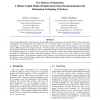380 search results - page 14 / 76 » Understanding human strategies for change: an empirical stud... |
KI
2008
Springer
13 years 7 months ago
2008
Springer
The complexity of pedestrian spatio-temporal behaviour calls for the combination of several complementary empirical methods in order to comprehensively understand human motion beha...
HICSS
1999
IEEE
14 years 6 days ago
1999
IEEE
Successful implementation of information technology (IT)-enabled strategy rests on the performance of IT professionals. Consequently, the development and retention of this "I...
ACMDIS
2006
ACM
14 years 1 months ago
2006
ACM
Designers generally agree that understanding the context of use is important in designing products. However, technologically advanced products such as personal robots engender com...
TOG
2012
11 years 10 months ago
2012
Compositing is one of the most commonly performed operations in computer graphics. A realistic composite requires adjusting the appearance of the foreground and background so that...
CHI
2008
ACM
14 years 8 months ago
2008
ACM
In this paper, we introduce the change of a mobile phone's hardware shape as a means of tactile interaction. The alteration of shape is implemented in a hardware prototype us...

